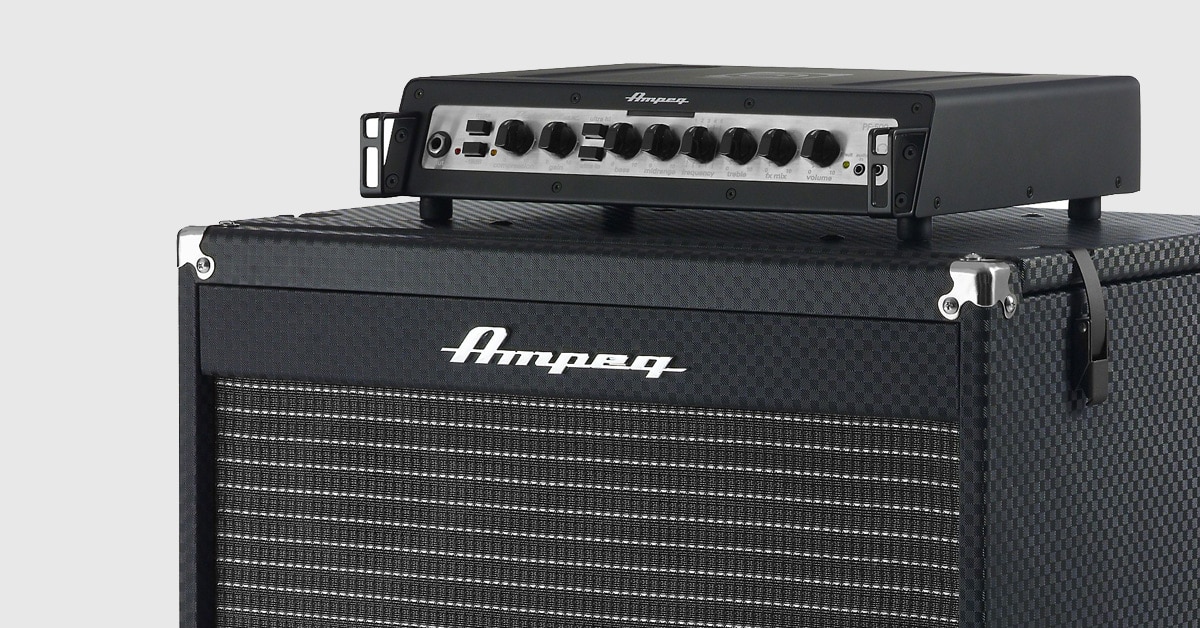The bass player’s role in the band is to maintain the rhythmic groove. Bassists, along with a drummer in most cases, create the music’s foundation, the so-called “pocket” over which the rest of the band—guitarists, horns, keyboards, strings, etc.—play. It takes a lot of juice plus hefty speakers to accurately reproduce the output of an electric bass, and there’s a vast selection of gear available to meet those requirements. In this guide we’ll primarily be addressing the amplification needs of the electric bass in modern band settings.
You’ll learn about the many bass amp options available as well as the bass speakers that are an essential part of most bass rigs. Whether you’re a beginning bass player looking for a first amp, an intermediate bassist wanting to expand your amplification setup, or a seasoned pro looking to update your rig, we’ll be exploring the right solutions for you.
Table of Contents
Bass Amplification Then and Now—A Brief History
The Eternal Debate: Tube Amps vs. Solid State vs. Hybrids
Features to Look for in Bass Amps
Bass Amp Heads
Bass Amp Stacks
Bass Combo Amps
Bass Preamps
Bass Speaker Cabinets
Summing Up
Bass Amplification Then and Now—A Brief History
It was Leo Fender’s invention in 1950 of the Precision Bass—the first electric bass of its kind—that created the need for an amp that could handle its demanding low-frequency output. In response, Fender soon came out with its Fender Bassman, a 50W tube-driven amp with a single 15” speaker. Over time, Fender refined the design shifting to a speaker cabinet containing four 10” speakers. The Bassman’s circuit redesign in 1958 became a much-copied gold standard in electric bass amplification.
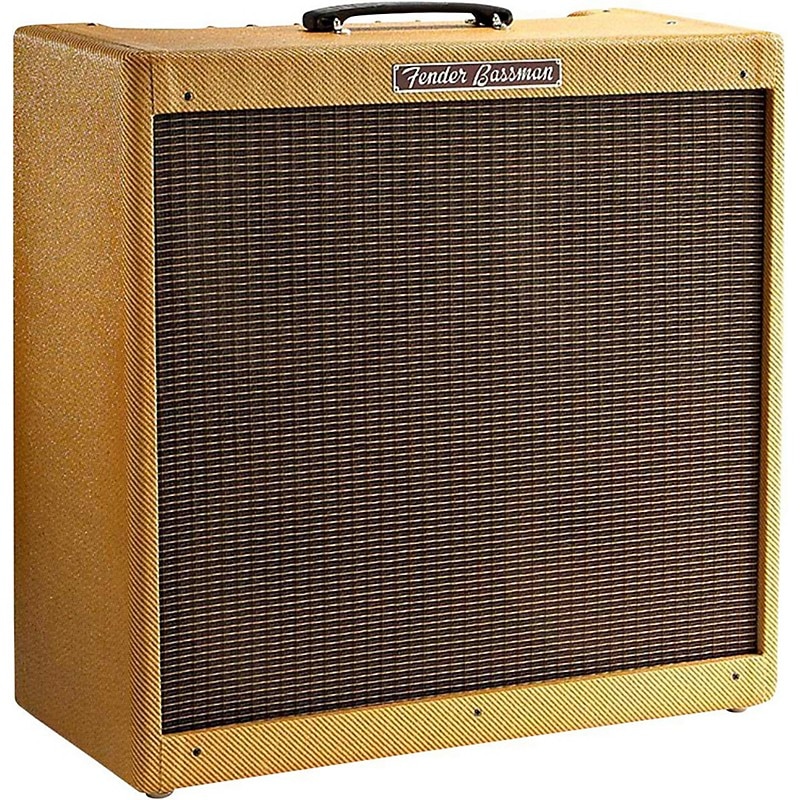
This Fender Vintage Reissue ’59 Bassman Combo is also a favorite among today’s guitarists who value its old-school sonics.
With the development of hard rock in the 1960s and 1970s the need for ever louder bass amps led to the use of stacks—amplifier heads mounted atop large speaker cabinets. The Who’s bassist, John Entwistle, was among the first to begin using multiple bass cabinets driven by powerful amp heads produced by Marshall in England.
In recent decades as PA systems grew more powerful, many pro bassists playing larger venues began sending their amp’s output direct to the house sound system. This approach makes for a cleaner, more controllable sound mix. That said, many bass players performing in smaller theaters and clubs still use on-stage rigs. One trend that has impacted bass players of all stripes is the move to more compact and portable solid-state and hybrid amplifiers. We’ll discuss these in greater depth in the Bass Amp Heads section below.
The Eternal Debate: Tube Amps vs. Solid State vs. Hybrids
Until the 1970s, most bass amps used vacuum tubes, and a few higher-end models still do. Some bassists prefer what they perceive as the warmer, more-natural sound that tube amp circuits produce. Tube-based amps produce a form of distortion when overdriven that is pleasing to fans of old-school bass sound. In comparing amp wattage, keep in mind that watt-for-watt, tube bass amps are considerably louder than solid state amps with similar power ratings.
During the 1970s, solid-state bass amplifiers using transistor technology became popular due to their lower weight, size, and cost. These amps were capable of producing the high-wattage output necessary to drive bass speakers at high volumes. Unlike tube amps, however, the form of distortion created by solid state amps when overdriven was not pleasant. Modern solid state gear includes circuits that emulate the warmth tube circuitry.
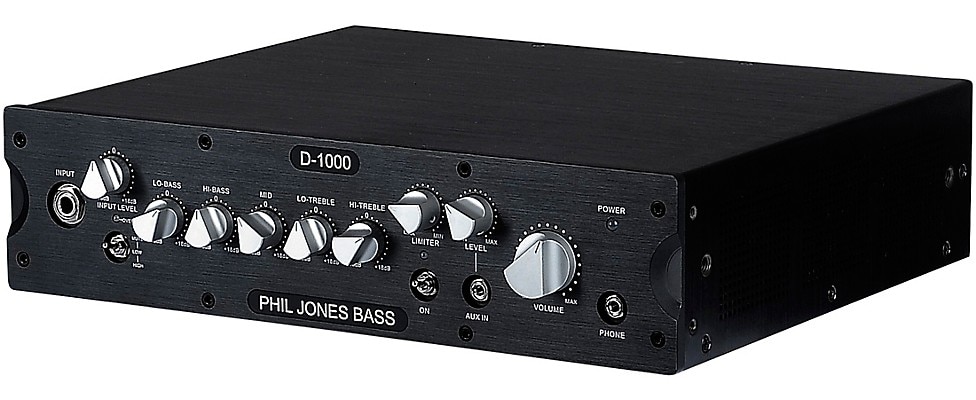
The Phil Jones Bass D-1000 is part of the trend toward powerful, ultralight bass guitar heads, offering 1,000 watts of power at only 5.3 lbs.
In recent years, new hybrid bass amps have entered the marketplace. These units typically have a tube-based preamplifier section and solid-state power stage. They produce warmer sound than solid-state units while being similar in size and heft. Overdriving the tube preamp front end of these hybrid bass amps can help replicate the warm distortion of tube amps.
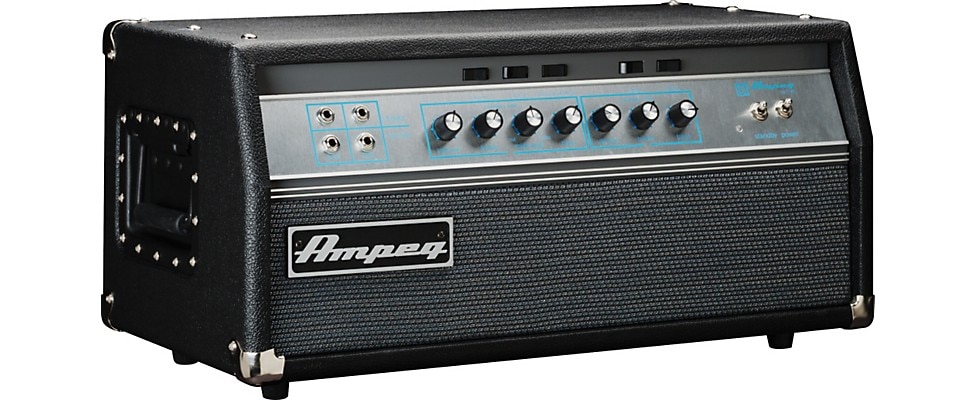
The Ampeg SVT-VR Vintage Reissue provides 300 watts of classic Ampeg SVT tone and power.
Features to Look for in Bass Amps
Tone controls: Most bass amps provide control over bass, middle, and treble frequencies to help you dial in a pleasing sound. Some models offer more sophisticated controls including parametric equalizers that split the amp’s output into more frequency bands for finer, more nuanced tone shaping. Some have a bright switch that can be engaged to add clarity to your your sound. Other specialized tone controls include shape and contour circuits. You’ll also find bass heads with EQ settings that are optimized to emulate certain retro bass sounds or to match specific music genres.
Multiple channels: Many amps have two or more channels. They’re often labeled as clean and overdrive, providing output to match the sound you’re going for. Some models have independent tone controls for each channel allowing you to switch between dramatically different sounds in mid-performance. Two or three channels also permits bi- or tri-amping your speakers—that is powering each speaker with a separate channel. Speaker cabinets that contain different-sized speakers are often powered this way. They use an active crossover network that splits the amp’s output into different frequencies tailored to each speaker.
Gain control: Most amps allow you to control the amount of overdrive in the preamp stage. Finding the gain “sweet spot” can help produce a warm overdriven sound.
Resonance and damping controls: These help fine-tune the amp’s output to the speakers you’re using. They can help produce a tighter, more focused sound from your speakers.
Direct output: Usually on the amp’s back panel, it allows the amp to be connected directly to a mixer or recording gear, sometimes using an XLR output. Some of these outputs feature a pre-post EQ switch and output level control to tailor the output for specific uses.
Switchable impedance: Usually these switches allow you to select between 4- or 8-ohm output to match the speakers you’re connecting to. A few models also provide a 16-ohm option as well.
Multiple speaker jacks: Because not all speakers and cables are created equal, having various types on your amps back panel can be an advantage. Options include ¼”, TRS, XLR, and Neutrik Speakon connectors. The key here is to make sure the amp you’re considering will readily connect to the speakers and other gear you use.
Passive/active inputs: If you play different basses with passive and active pickups, this option is important.
XLR balanced inputs: Seen on a few amps, it allows acoustic double bass players to mic their instrument then run the mic’s output through the amp.
Footswitch jack: Using a footswitch allows you to control effects, switch between channels, and control other parameters without taking your hands of your bass.
Effects loop: This allows external effects to modify the signal between the preamp and the power section. You simply run a patch cord from your effects loop output to the input of the effects box. Another cord connects the output of the effect back into the input on the effects loop, after which the signal goes to the power section of the amp.
Built-in tuner: A few bass amps offer this convenient feature, usually with a display that allows you to tune silently onstage.
Mute switch: It allows you to silence the amp while tuning, switching instruments, or taking a break.
Switchable power supply: If you plan to travel overseas, this switch is a handy way to match your amp with the local power supply without having to use external converters.
VU or clipping meter: Some amps have a front panel needle-type meter showing your amps output in real time. Others use LEDs or other lamps to indicate conditions such as clipping.
Bass Amp Heads
As noted above, bass head amplifiers fall into three categories according to the type of circuitry they use. The great news for bass players today is the fact they have plentiful choices in all three categories.

Weighing in at just six pounds, the Little Mark 800 from Markbass generates a mighty 800 watts.
New bass players with tight budgets will find affordable, lower-wattage solid state and hybrid amps that are more than powerful enough to work in band settings. They may not offer all the tone-tweaking capabilities and enormous output of more costly heads, but for bedroom and garage jam sessions, they’ll provide more than adequate bottom end.
More advanced players who regularly gig in small to medium sized venues can choose from a wide range of heads that typically produce 300-700 watts of output, offer sophisticated tone controls, and have versatile output sections allowing connection to a variety of speaker combinations or sound systems as well as direct connection to recording gear and mixers.
Weekend warriors and touring pro bass players will likely focus on hybrid or tube-driven bass heads that create the kind of tone and output that best matches their music. Those who travel a lot will probably opt for one of the new breed of compact yet powerful heads.
Bass Amp Stacks
Some manufacturers offer amp heads and speaker cabinets that are carefully matched for optimal performance. You’ll find a range of bass amp stacks designed to meet the needs of various playing situations and budgets. There are full-sized stacks that include speaker cabinets loaded with the classic configuration of four 10” speakers as well as dual 10” speaker cabs. Some have a single 12” speaker cabinet.
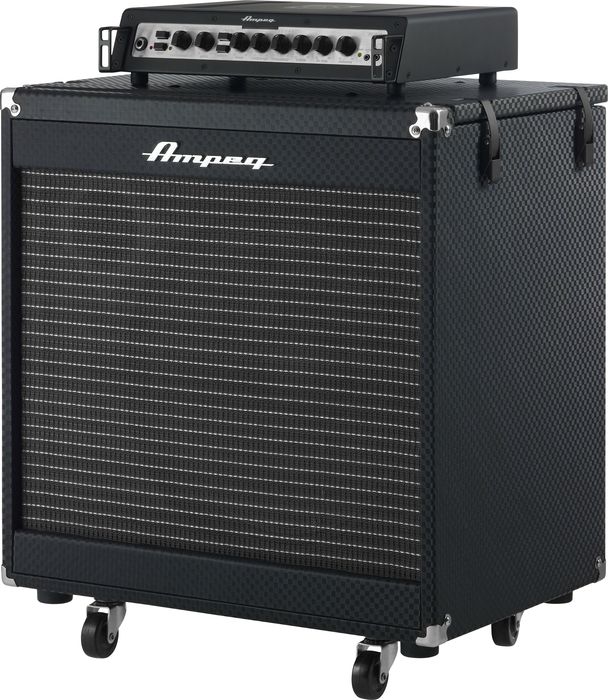
The Ampeg PF-500 Portaflex stack teams a 500W head with a 15” Eminence speaker for plaster-shedding low frequencies.
So-called mini-stacks are ideal for practice and beginners on tight budgets. They often have a single 10” speaker and a modestly powered amp that’ll still produce plenty of power for bedroom concerts.
Bass Amp Combos
If you’re looking for a portable, all-in-one bass amplification solution, the bass combo is what you’re looking for. By integrating the amp and speaker(s) into a single cabinet, cabling and component-matching issues are eliminated. You’ll find a wide range of combos in terms of amp wattage and speaker configurations.
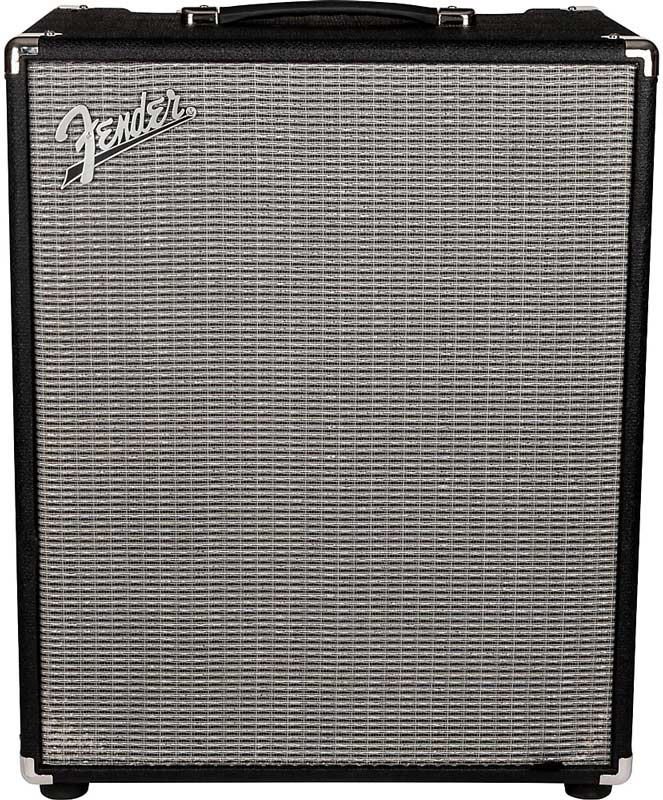
The 2-10" speakers driven by by a 500W power amp make the Fender Rumble 500 Combo a punchy and portable choice for the weekend warrior bassist.
For practice sessions, there are little 15W units with a single 8” or 10” speaker that can put out a surprising amount of sound while keeping the peace with neighbors and family. You’ll also find beefier bass amp combos equipped with solid state amps putting out 500W or more into a pair of 10” speakers or a single 12” driver. Some of these units will serve double duty as floor monitors onstage, and certain models tilt back to improve sound projection.
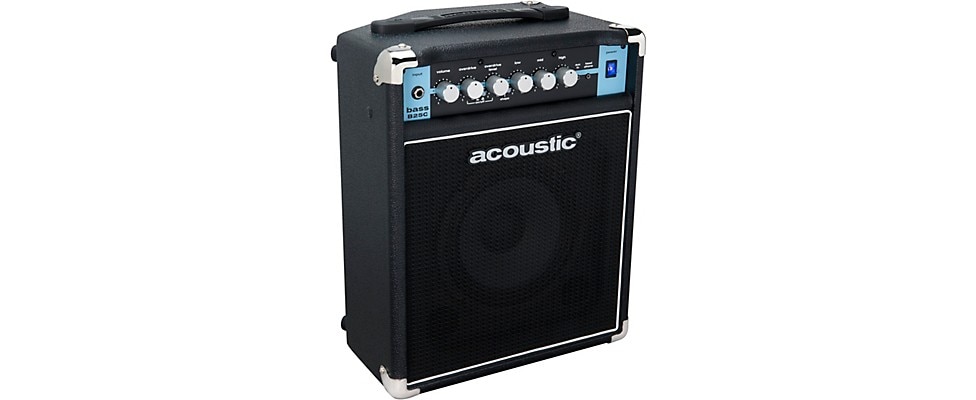
The Acoustic B25 25 Watt Bass Combo Amp features a custom-designed 8" Ferrite speaker.
Bass Preamps
While bass heads and combos contain their own preamp section—where you do all that tone shaping—there’s a thriving market in external bass preamp modules. Mostly designed to please the finickiest tone tweakers, they can be a useful buy if your rig lacks the tone shaping tools you need to dial in specific sounds or optimize your rig for difficult venues. Many include semi-parametric EQ circuits that let you fine-tune your bass sound to perfection. Some offer dual channel operation and footswitches for on-the-fly tone shaping.
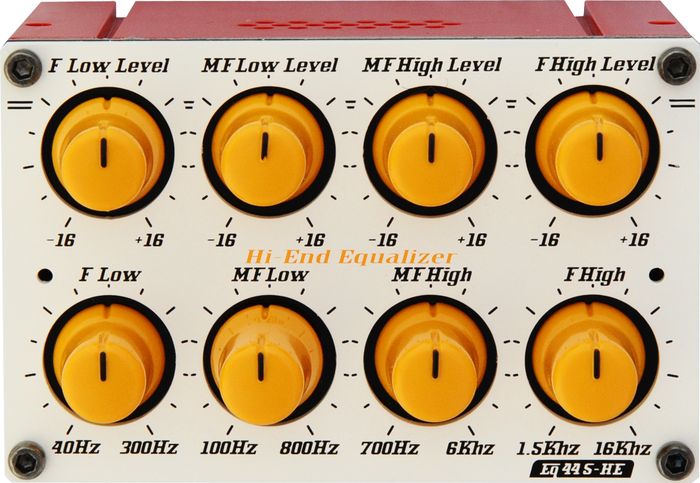
The Markbass MoMark EQ44S-HE Bass EQ Module adds a very compact 4-band semi-parametric EQ section to your bass rig.
Bass Speaker Cabinets
When shopping for bass speaker cabs, your main concerns should be the types of venues you play, the styles of music you perform, and the amp you’ll be driving the speaker cabinet with. Size and weight are another consideration, especially if you plan to take your speaker cabs on the road. If you own a compact car, you better read dimensions carefully to be sure you’ll be able to get the cab in. The massive magnets used in bass speakers account for a substantial part of their weight. Neodymium magnets are a weight-saving feature to look for in shopping for lighter bass cabinets.
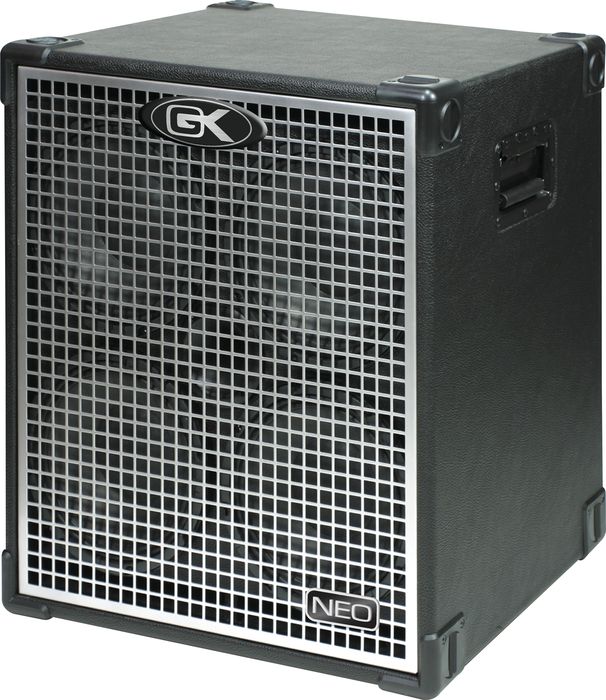
Gallien-Krueger’s Neo 410 speaker cabinet has weight-saving neodymium magnets for a lighter load-in.
Because of the demanding nature of bass frequencies, bass speaker cabinets need to be very solidly built and braced to prevent unwanted rattles, buzzes, and unwanted resonance. Most cabs include ports or vents that increase speaker efficiency. Acoustic-suspension speakers that are mounted in sealed cabs are fairly rare in the bass world since they tend to be less efficient.
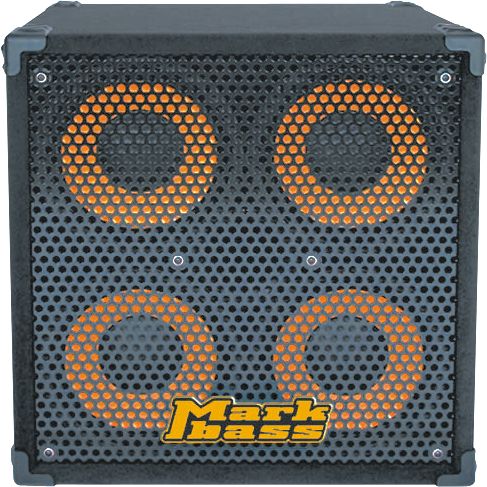
The Markbass Standard 104HR 4x10 cabinet delivers a lot of punch at just 56 lbs.
Bassists seeking the extremely powerful low-end response needed for modern R&B, gospel, and hip-hop sometimes use subwoofers designed for PAs. They’re usually used in conjunction with standard bass speakers.
Generally speaking, smaller bass speakers are punchier and are ideal for styles like rock and funk. They’re ideal for “slap and pop” thumb-style playing techniques since their relatively smaller cones respond quickly to rapid percussive effects. Many cabs are loaded with either two, four, or even eight 10” speakers, giving you many models to choose from.
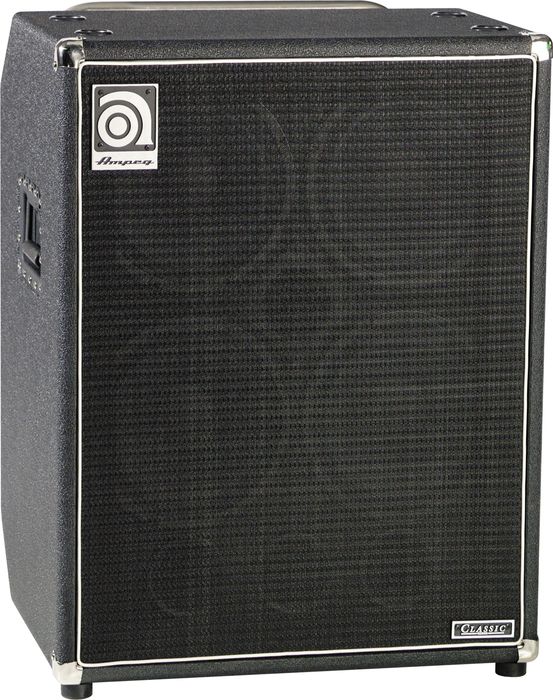
Ampeg’s SVT 410-HLF 4x10 cab is tuned for extra-deep response making it ideal for 5-string bass players.
Larger 12” and 15” speakers produce a fatter and rounder tone that’s appropriate for jazz and for amplifying acoustic basses.
Some speaker cabinets contain a mix of speaker sizes including ruggedly built tweeters designed to handle bass output. These cabinets often take advantage of bi-amping or tri-amping to direct the amp’s output according to frequency to specific speaker drivers using an active crossover network.
Summing Up
You should now have some good basic information about the kinds of bass amplification gear that’s out there as well as the things to look for when shopping.
Reading professional online reviews of various bass amp gear can be helpful in pinpointing the right rig for your needs. You’ll also find hundreds of bass amplification product reviews from fellow players on the Musician’s Friend website.





































































































































